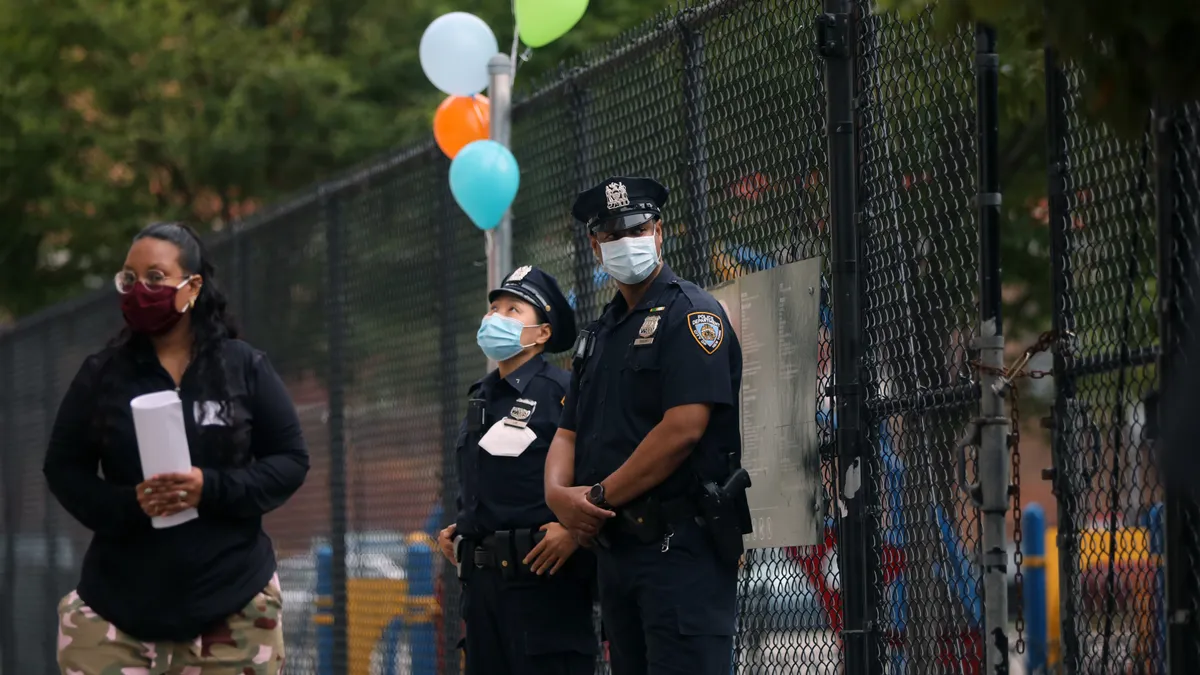Dive Brief:
- In a new report, the Council of Parent Attorneys and Advocates calls for the end of police presence in schools, saying despite decades of funding and support for school policing, there is little evidence police cultivated positive relationships in schools or helped prevent school shootings.
- COPAA and other organizations have suggested instead of police in schools, schools should ensure staff are better trained in addressing challenging student behaviors; use evidence-based reading instruction and supports; use alternatives to suspensions and expulsions; increase the hiring of school counselors and psychologists; and fulfill obligations to provide behavioral supports to students with disabilities.
- The debate about the responsibilities of police at schools also includes those who say police-school partnerships can help keep students safer. They suggest clearer memorandums of understanding between schools and police departments and more specialized training for police officers on campuses.
Dive Insight:
The movement to reform police activity on K-12 campuses, which had been building over the past 10 years, grew more intense after the 2020 murder of George Floyd by a police officer, leading school systems like Chicago Public Schools and Los Angeles Unified School District to significantly reduce and alter police presence at schools.
Those supporting the elimination of police on campuses say law enforcement at schools has contributed to the school-to-prison pipeline because of increased arrests for noncriminal activity.
Organizations like COPAA also say children with disabilities and students of color are disproportionately caught up in the juvenile justice system for on-campus incidents that could have been addressed by school staff. Police presence at schools increases the likelihood law enforcement will be involved in less-serious school-based behavior, COPAA said in the report.
Statistics from the Civil Rights Data Collection for the 2017-18 school year — the most recent national-level data figures available — show student referrals to law enforcement increased 12% compared to the year before.
Black students, who made up 15.1% of the total student population, accounted for 28.7% of all students referred to law enforcement and 31.6% of students arrested at school or during a school-related activity.
Black students with disabilities, who account for 2.3% of the student population, comprised 8.4% of the population referred to law enforcement and 9.1% of those arrested. A referral to law enforcement involves situations where a school official reports a student to the police.
Additionally, several civil rights groups have recently challenged the use of school threat assessments — a process for evaluating the probability of a student causing harm to others, which sometimes involves law enforcement. The groups say the practice leads to a disproportionate number of students with disabilities, students of color and students from low-income families as the focus of investigations.
“Right now, the police are being relied on to handle all kinds of discipline and minor infractions or codes of conduct — things that do not need police intervention,” said COPAA CEO Denise Marshall.
But a complete dissolution of the school-police relationship is not recommended, Marshall said, because schools need police assistance in extreme emergencies and to help build evidence-based, trusting relationships within communities.
Those relationships need to be thoughtfully coordinated so the culture shifts from a punitive approach to a whole-child, whole-community positive approach, she said.
The National Association of School Resource Officers, which has been highlighting SRO Success Stories of officers keeping students and schools safe, also says SROs should not be involved in formal school discipline proceedings.
NASRO promotes the formation of memorandums of understanding that clearly define the role of SROs in schools, as well as specialized training for SROs that includes adolescent brain development and deescalation techniques.
“Our role is not to deal with school discipline,” said NASRO President D.J. Schoeff, a sergeant with Indiana’s Carmel Police Department and a SRO for Carmel Clay Schools, in a recent WFYI interview. “Our role is to try to help our kids make good decisions.”
The National Association of Secondary School Principals offers recommendations for district and school leaders on positive school-police partnerships, including the avoidance of restraint and seclusion practices and training of school staff on discipline management responsibilities.







 Dive Awards
Dive Awards





